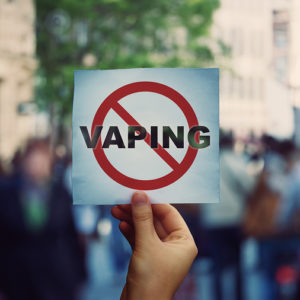Editor’s Note: For another view, please see Point: FDA Should Regulate E-Cigarettes to Limit Access to Youths
Never let a crisis go to waste. That could be the official motto for the anti-tobacco industry, which has irresponsibly exploited this summer’s sudden outbreak of “vaping-related” lung ailments.
With the aid of sloppy news reporting and biased announcements from federal officials, anti-tobacco advocates have successfully deceived the public into thinking that “vaping” is to blame. As if failing to warn consumers about a real health threat wasn’t bad enough, advocates have also used the confusion they helped create to railroad the political process and enact new regulations on the legal e-cigarette market.
These reckless measures, like the recently announced ban on e-cigarette flavors in Michigan, will not only fail to improve public health but also put consumers at greater risk.
Michigan governor Gretchen Whitmer announced that her state would be the first in the nation to enact a total ban on the sale of all e-cigarette flavors (except tobacco-flavor), which she believes “hook young people on nicotine.” She also believes banning these flavors will protect kids and the health of other Michigan residents.
On both accounts, she is dead wrong. Bans don’t work. Bans never work. All bans do is push consumers to make different, usually more risky, choices. In this case, the likely outcome of banning e-liquid flavors people want is that they will seek to obtain them through the black market or simply return to smoking cigarettes. As a result, many more will die of smoking-related diseases or tainted products.
Despite the repeated claim that this summer’s outbreak of lung diseases is “linked to vaping” or “e-cigarettes,” not a single one of the more than 400 cases have been connected to legal, nicotine-containing, e-cigarettes. On the contrary, state health departments have revealed that most of the cases appear linked to the use of black market cannabis e-liquids, many of which have tested positive for Vitamin E Acetate, which when inhaled, can damage the lungs. In New York state, for example, the health department announced that all of the patients in the outbreak who submitted products for testing had used a Vitamin E-tainted product.
To be clear, this does not appear to be a problem with cannabis products bought through licensed retailers. The majority of the cases have occurred in states and counties where cannabis is not legally available and, as such, consumers are more likely to take their chances on the black market.
After some pressure, federal authorities finally had to acknowledge that the outbreak was not linked merely to “vaping,” but to vaping unlicensed marijuana. Yet, some — like the Centers for Disease Control — continue to exploit the crisis to spread unwarranted fears about e-cigarettes. And anti-vaping advocates are capitalizing on the confusion to promote restrictions and outright bans on these products that have helped millions of American smokers quit their deadly habit over the last decade.
We don’t yet know what caused all of the illnesses in this outbreak. We also don’t know all of the long-term effects of vaping. But, we do know that smoking kills. Nearly half a million Americans die each year from illnesses caused by combustible tobacco.
But, e-cigarettes, which deliver nicotine without combustion, have a significantly lower risk. Research also repeatedly shows that e-cigarettes are an effective way for cigarette smokers to quit, more effective even than traditional nicotine replacement therapies. Instead, they focus on evidence that supposedly supports the existence of an “epidemic” of youth vaping, even though that same evidence shows that only 0.2% of non-smoking, underage high school students regularly use e-cigarettes. They also wisely avoid mentioning the fact that even amid this so-called epidemic, the rate of smoking among all age groups has dropped to the lowest ever on record.
The claim that Big Tobacco is using fruity flavors to hook a new generation on nicotine is compelling. Big Tobacco makes for an easy target, after all. But, scientific data actually indicate that e-cigarette flavors do not attract non-smoking adolescents. On the contrary, the wide array of flavors, produced by thousands of vapor companies around the country — most of them small — appear to be critical in persuading smokers to try vaping and preventing e-cigarette users from returning to their deadly cigarette habit.
Concerns about the potential risk e-cigarettes may pose to adolescents is warranted. But, the life-saving potential e-cigarettes have for adult smokers merits extreme caution — an objective weighing of the risks and benefits posed by regulating these products. Currently, the evidence indicates that the risk associated with e-cigarettes is small, smoking rates in all age groups are declining, and flavored e-cigarettes play an important role in smoking cessation. The specter of possible, “unknown” risks to adolescents simply isn’t enough to justify a ban.
As a society, we have found satisfactory ways to address youth access to many adult products, like alcohol and marijuana. Given that e-cigarettes have the potential to save lives, regulators have a responsibility to find a similarly sophisticated solution to the youth vaping problem. Or, they can follow Michigan’s lead and learn the same lesson repeated throughout history: prohibition always causes more problems than it solves.

